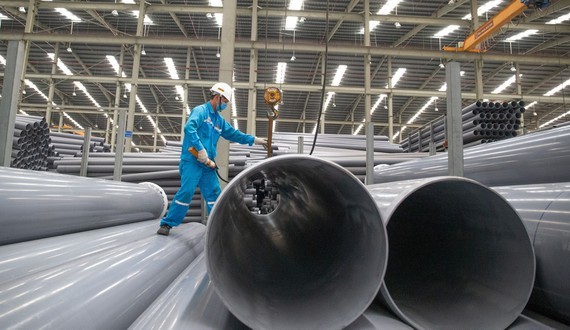 Since the beginning of this year, enterprises have strived to maintain production stability in the face of the storm of raw material prices. (Photo: SGGP)
Since the beginning of this year, enterprises have strived to maintain production stability in the face of the storm of raw material prices. (Photo: SGGP)
Difficulties accumulate Ms. Ly Kim Chi, Chairwoman of the Food and Foodstuff Association of Ho Chi Minh City, said that since the beginning of the year, enterprises have strived to maintain production stability in the face of the storm of raw material prices. Specifically, the prices of imported seasonings and food additives edged up by 5-10 percent; plastic materials for production surged by 15-70; packaging rose by 10-15 percent; rubber gloves soared by 300 percent. Domestic raw materials, such as rice, seafood, and sugar, also climbed by 5-20 percent. Recently, the Vietnam Association of Seafood Exporters and Producers (VASEP) has sent an official dispatch to the Ministry of Justice, requesting it to consider suspending the increase in fees for the use of infrastructure works, service works, and public utilities at seaport border gate areas, especially at seaports in HCMC. VASEP stated that currently, depending on the type of goods, the payable costs of enterprises are extremely high. Specifically, enterprises have to pay VND2.2 million for a 20-foot container and VND4.4 million for a 40-foot container of dry cargo for temporary import and re-export cargo, cargo in bonded warehouses, transit cargo, and transshipment, and VND15,000 per ton of liquid cargo and breakbulk for imported and export goods that open customs declarations in HCMC. According to VASEP, more than 70 percent of imported seafood products are gathering at the seaports of HCMC. Thus, a seafood enterprise in Khanh Hoa Province with 3,000 export containers per year will have to pay VND7.5 billion per year for the BOT station fee and VND5.5 billion per year for a new one at Cat Lai Port – an extremely high cost for businesses. Meanwhile, enterprises are facing more difficulties when purchasing power decreases. Information from the General Statistics Office of Vietnam shows that the total retail sales of goods and revenue from consumer services in May were estimated at VND393.6 trillion, down 3.1 percent compared to the previous month and 1 percent year-on-year. Also, in the first five months of the year, the whole country recorded that 59,800 enterprises halted operations for a certain period, stopped operations to wait for dissolution procedures, and completed dissolution procedures, up 23 percent compared to the same period last year. Of the enterprises, 31,800 temporarily suspended operations, up 22.3 percent year-on-year; 20,000 stopped operations and waited for dissolution procedures, an increase of 20.7 percent; 8,000 completed dissolution procedures, up 32.3 percent. On average, nearly 12,000 enterprises withdraw from the market every month.It is essential to reduce the burden on businesses According to Ms. Ly Kim Chi, many members of the Food and Foodstuff Association of HCMC have simultaneously proposed the People's Committee of HCMC to consider suspending the increase in fees for the use of infrastructure works, service works, and public utilities in the seaport border gate areas, especially at seaports in the city. HCMC is one of the three major seaport cities of the country, along with Hai Phong and Da Nang cities. The average annual growth rate of cargo throughput is 5 percent. Even during the Covid-19 pandemic, the demand for import and export goods in the Southern provinces still climbed by nearly 20 percent, and HCMC alone went up by over 5 percent. The city's seaport system plays a key role in connecting transport in the Southeast region and the Mekong Delta, with the main port clusters of Cat Lai, Saigon, and Hiep Phuoc. However, up to now, the transport infrastructure system connecting with ports in the area has not been synchronized yet. Narrow roads cause constant traffic jams, increasing logistics costs and reducing port operation efficiency. For example, at Cat Lai Port, the road system can only handle about 12,000 vehicles per day and night. Meanwhile, the actual traffic has risen to 19,000-20,000 units per day and night. Sometimes, the number of vehicles even increases to 26,000. Therefore, it is urgent to invest in and upgrade the infrastructure around ports to help vehicles transport faster, create conditions to reduce logistics costs and improve competitiveness for enterprises. In the long term, the increase in fees to help the city to have more money to reinvest in the port system is essential. However, amid the context that the Covid-19 pandemic develops complicatedly, and the cost of input materials is increasing sharply, raising infrastructure service fees at ports will make it more and more difficult for businesses. Currently, Hai Phong - the largest seaport area in the North - has also adjusted and lowered the fees for using infrastructure works, service works, and public utilities twice in order to reduce pressure on businesses. Ms. Ly Kim Chi said that the upcoming months are the peak time for enterprises to import raw materials. Enterprises have proposed the city consider delaying the implementation of the fee collection phase 1 from January 1, 2022, and phase 2 from June 1, 2022, instead of 2021. At the same time, it is necessary to cut the rates lower than those proposed in the draft to reduce the burden on enterprises, creating conditions for enterprises to recover and develop after the impact of the Covid-19 pandemic, as well as improving competitiveness in price with other countries in the region.
Besides, according to many enterprises, the Ministry of Industry and Trade should promote cooperation with e-commerce platforms to help enterprises increase their market share for domestic consumption, as well as for export. On the other hand, they should diversify the import markets of raw materials for production, helping to reduce the pressure on increasing the selling prices of products for enterprises.
























